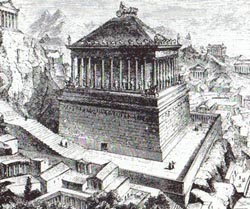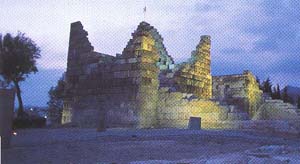History & Historical Places of Bodrum

Heredotus, the famous historian and known as the father of history, was born in Halikarnassos (ancient name of Bodrum) in 484 B.C. and according
to him Bodrum was founded by the Dorians in the 12th century B.C. The next settlers were Carian and Lelegians.In 546 B.C., the region came under Persian rule. In
the beginning of the 4th century B.C., Caria region was ruled by the Satrap Hekatomnos and his son Mausolos.Its most brilliant period was
around 353 B.C., when Halikarnassos was the capital of the satrap of Caria. After the death of King Mausolos, Caria was ruled by his wife and
sister Artemisia II. and the Mausoleum, the monumental tomb, was built by Artemisia II in honour of her husband and brother King Mausolos. This
monument became one of the seven wonders of ancient world, and was destroyed by an earthquake in the 14th century.
In 192 B.C., Halikarnassos ruled by Roman Empire but did not develop very much. In 395 A.D., Halikarnassos came under Byzantine rule. In XIth
century, city was conquered by Turcs but during the first crusade changed hands several times. The Knight of Rhodes captured Halikarnassos in 1402
and the city was called Petronium. Knights of Rhodes was built the castle between two harbours. It was reinforced with Italien, English, German,
Spanish and French towers.
Bodrum was taken by the Turks in 1523.
 Bodrum Castle
Bodrum CastleBodrum Castle was built by the Knights of Rhodes in honour of St.Peter between 1415-1437. The stones and marbles of the Mausoleum,
which is one of the seven wonders of ancient world and destroyed by an earthquake in 14th century, were used for the construction of the castle. There are five
main towers, reflecting the architectural styles of the nations by whom they were constructed, called English Tower, French Tower, Spanish Tower, Italien Tower
and German Tower. The Knights built the walls facing the sea thin, and fortified the walls facing the land, as they had expected attacks from the land.
Bodrum was taken by the Turks in 1523. After 1895, the castle was used as a prison. It was converted into a museum, in which, especially the findings of
underwater archeology, Mycenean, Hellenistic, Roman and Byzantium artifacts are displayed in different sections in chronological order since 1960.

In the Gothic
chapel in the courtyard, findings from the Bronze Age are exhibited, dating back 3000 - 2000 years, discovered in this region of objects and weapons from the
Mycenaen time found by excavation in the necropolis near Bodrum - Ortakent. In the section to the right of the chapel are exhibited in their original position the
environs of the Gelidonya Wreck, which had loaded copper ignots, dating back to 1200 B.C. and which was discovered by underwater excavations off-shore the Cape
Gelidonya, under direction of Prof.Dr. George Bass in 1960.
In the south of the chapel, adjoining the castle wall a Turkish Bath an old building where the bathing tradition is shown in details.

A narrow street to the left of the chapel leads to the
Amphora Park. From here one comes to the
Hall of the Glass wreck, where the Wreck of Serce
Harbour and environs are displayed, in the vis-a-vis Glass Hall and glass works between the XIVth century A.D. and the whole glass collection of the Wreck of
Serce Harbour are exhibited.

In the upper section of the Castle the towers are placed. In the Italien Tower, the ground floor is
The Coins and jewellery Hall
beginning from the 7th century B.C., until the Roman and Ottoman periods are displayed. In the middle floor of the tower is
The Hall of Classical Period.
Various ceramic and bronze objects and statues dating back to the 5th century are exhibited here.
Baltali Tower is situated at the highest point of
the castle, houses the
Carian Princess Hall and one of the most interesting place of the Museum. In 1989 a sarcophagus was found entering Bodrum. From the
jewellery of the skeleton found in sarcophage, it was identified as
Princess Ada, who was also the adoptive mother of Alexander the Great. The University
of Manchester plastered the scaleton of Princess to her state while living and she is now exhibited in a niche in the hall.
 Mausoleum
MausoleumMausoleum constructed as a funereal monument by Artemisia, queen of Caria after the death of her brother & husband Mausolos, the Satrap
of Caria 352 B.C., the architect was Pytheos. The four facades were decorated with relief friezes executed by (the eastern facade) Scopas , (the northern facade)
Byraix , (the southern facade) Timotheos , and (the western facade) Leochares. The monument is raised on a high podium. The 21 stepped roof is supported by
36 ionic columns. Statues of Mausolos and Artemisia, riding a chariot drawn by four horses from the crest of the monument are now to be found in the British
Museum. The ground measurements of the monument are 60X80 m. and it was originally 46 m. in height. It remained intact until the 12 century A.D., was
partially destroyed by an earthquake in the 14th century, and demolished Knights of Rhodes. The friezes were removed to the British Museum in 1856.
 Antique Theatre
Antique TheatreSituated in the hillside over looking Bodrum. This theatre whose capacity is around 13.000 was built during Carians' reign in
Hellenistic age (330-30 B.C.) The theatre consists of three different sections: a place for audience, a place for an orchestre and the stage. It became an
open-air museum after the excavations made in 1973.
 Myndos Gate
Myndos GateLocated on the west side of Bodrum, this is one of the two entrances of ancient Halikarnassos. Only some parts of the city wall
remained until today. An important part of the town wall was the Myndos Gate where the soldiers of Alexander the Great had a hard time to enter the town of
Halikarnassos in 333 B.C. After he captured the city, except the Mausoleum whole city destroyed by the soldiers of Alexander the Great.


 Heredotus, the famous historian and known as the father of history, was born in Halikarnassos (ancient name of Bodrum) in 484 B.C. and according
to him Bodrum was founded by the Dorians in the 12th century B.C. The next settlers were Carian and Lelegians.In 546 B.C., the region came under Persian rule. In
the beginning of the 4th century B.C., Caria region was ruled by the Satrap Hekatomnos and his son Mausolos.Its most brilliant period was
around 353 B.C., when Halikarnassos was the capital of the satrap of Caria. After the death of King Mausolos, Caria was ruled by his wife and
sister Artemisia II. and the Mausoleum, the monumental tomb, was built by Artemisia II in honour of her husband and brother King Mausolos. This
monument became one of the seven wonders of ancient world, and was destroyed by an earthquake in the 14th century.
Heredotus, the famous historian and known as the father of history, was born in Halikarnassos (ancient name of Bodrum) in 484 B.C. and according
to him Bodrum was founded by the Dorians in the 12th century B.C. The next settlers were Carian and Lelegians.In 546 B.C., the region came under Persian rule. In
the beginning of the 4th century B.C., Caria region was ruled by the Satrap Hekatomnos and his son Mausolos.Its most brilliant period was
around 353 B.C., when Halikarnassos was the capital of the satrap of Caria. After the death of King Mausolos, Caria was ruled by his wife and
sister Artemisia II. and the Mausoleum, the monumental tomb, was built by Artemisia II in honour of her husband and brother King Mausolos. This
monument became one of the seven wonders of ancient world, and was destroyed by an earthquake in the 14th century.
 Bodrum Castle
Bodrum Castle In the Gothic
chapel in the courtyard, findings from the Bronze Age are exhibited, dating back 3000 - 2000 years, discovered in this region of objects and weapons from the
Mycenaen time found by excavation in the necropolis near Bodrum - Ortakent. In the section to the right of the chapel are exhibited in their original position the
environs of the Gelidonya Wreck, which had loaded copper ignots, dating back to 1200 B.C. and which was discovered by underwater excavations off-shore the Cape
Gelidonya, under direction of Prof.Dr. George Bass in 1960.
In the Gothic
chapel in the courtyard, findings from the Bronze Age are exhibited, dating back 3000 - 2000 years, discovered in this region of objects and weapons from the
Mycenaen time found by excavation in the necropolis near Bodrum - Ortakent. In the section to the right of the chapel are exhibited in their original position the
environs of the Gelidonya Wreck, which had loaded copper ignots, dating back to 1200 B.C. and which was discovered by underwater excavations off-shore the Cape
Gelidonya, under direction of Prof.Dr. George Bass in 1960.
 A narrow street to the left of the chapel leads to the Amphora Park. From here one comes to the Hall of the Glass wreck, where the Wreck of Serce
Harbour and environs are displayed, in the vis-a-vis Glass Hall and glass works between the XIVth century A.D. and the whole glass collection of the Wreck of
Serce Harbour are exhibited.
A narrow street to the left of the chapel leads to the Amphora Park. From here one comes to the Hall of the Glass wreck, where the Wreck of Serce
Harbour and environs are displayed, in the vis-a-vis Glass Hall and glass works between the XIVth century A.D. and the whole glass collection of the Wreck of
Serce Harbour are exhibited.
 In the upper section of the Castle the towers are placed. In the Italien Tower, the ground floor is The Coins and jewellery Hall
beginning from the 7th century B.C., until the Roman and Ottoman periods are displayed. In the middle floor of the tower is The Hall of Classical Period.
Various ceramic and bronze objects and statues dating back to the 5th century are exhibited here. Baltali Tower is situated at the highest point of
the castle, houses the Carian Princess Hall and one of the most interesting place of the Museum. In 1989 a sarcophagus was found entering Bodrum. From the
jewellery of the skeleton found in sarcophage, it was identified as Princess Ada, who was also the adoptive mother of Alexander the Great. The University
of Manchester plastered the scaleton of Princess to her state while living and she is now exhibited in a niche in the hall.
In the upper section of the Castle the towers are placed. In the Italien Tower, the ground floor is The Coins and jewellery Hall
beginning from the 7th century B.C., until the Roman and Ottoman periods are displayed. In the middle floor of the tower is The Hall of Classical Period.
Various ceramic and bronze objects and statues dating back to the 5th century are exhibited here. Baltali Tower is situated at the highest point of
the castle, houses the Carian Princess Hall and one of the most interesting place of the Museum. In 1989 a sarcophagus was found entering Bodrum. From the
jewellery of the skeleton found in sarcophage, it was identified as Princess Ada, who was also the adoptive mother of Alexander the Great. The University
of Manchester plastered the scaleton of Princess to her state while living and she is now exhibited in a niche in the hall.
 Mausoleum
Mausoleum Antique Theatre
Antique Theatre Myndos Gate
Myndos Gate